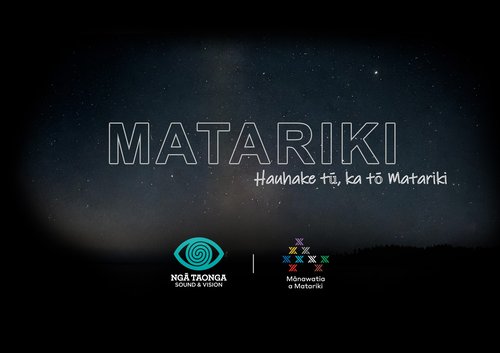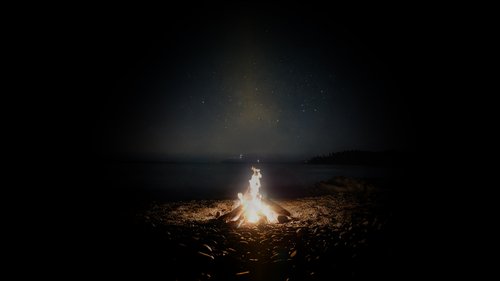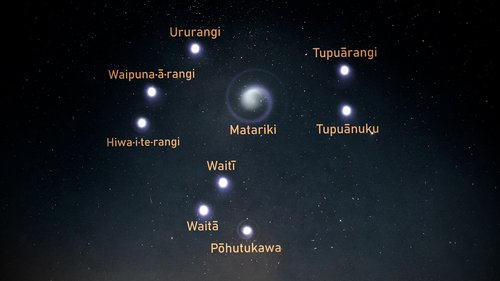
"Hauhake tū, ka tō Matariki."
"The harvest ends when Matariki sets."
Ko te ingoa i tapaina ki te kiriata i tēnei tau ko "Hauhake tū, ka tō Matariki”.
He whakataukī tēnei e tohu ana ki te iwi, kua mutu te wāhi ki te hauhake kai.
Mō te nuinga o ngā iwi, i whakahuatia tēnei whakataukī i te otinga o te marama o Haratua, he mea whakamōhio atu ki te iwi e rewa ana a Matariki i te ata hāpara, nā whai anō kua tau mai ngā hau pupuhi o te hōtoke.
Tōna tikanga i te whakahuatanga mai o tēnei whakataukī kua mutu i ngā iwi te kohikohi kai me te whakakī i ō rātou pātaka kai, ā, he rahinga kai kua haipū ki ngā pātaka kia whāngai i ngā uri mō te roanga atu o Matariki me ngā marama mātao o Hine Takurua.
Ko te kaupapa matua mō Matariki i tēnei tau ko te 'Heri Kai'. Nā i roto i tēnā hei aronga mō te kaupapa, ka ara ake ngā huatau he aha i whai tikanga tēnei kāhui whetū ki ngā iwi Māori, he oti ngā tohu ka puta i a Matariki, kia mārama te kite me aha e tika ai te whakarite mō te tau hou.
I roto i te whitiata nei ka aro ki ngā tamariki a Matariki e hāngai ana ki te kai. Ko Tupuānuku, ko Tupuārangi, ko Waitī rātou ko Waitā, ka āta tirohia te āhua e ari ake ko ngā tohu e hāngai ana ki tērā, ki tērā.
Ka whakaatu i ngā āhua whakahirahira o te tupu kai, te hauhake kai, te hao ika, te pāwhara tuna ka mutu te whakarite kai mō ngā mārama mātao.
To celebrate Matariki 2024, Ngā Taonga Sound & Vision is proud to present Hauhake tū, ka tō Matariki, a special compilation of audiovisual taonga from our collection. This year, we were inspired by the whakataukī (proverb) "Hauhake tū, ka tō Matariki" – the harvest ends when Matariki sets – and the consideration of food during the Matariki period.

Historic context
In the months leading up to Matariki, iwi Māori traditionally spent a significant amount of time planning for the cold months of winter. During this time preparations involved harvesting planted crops, hunting for birds, fishing, and catching eels. Each iwi used different techniques to collect and preserve the food that was then stored in pātaka kai (storehouses/pantries).
A great deal of preparation and planning was put in place during this period. The objective within this timeframe was for iwi to ensure there would be a sustainable crop of food stored within the pātaka that would see them through the winter months. If food sources were not adequately stored before the setting of Matariki, this led to famine, or worse, loss of lives.
In the month of May, the Matariki star cluster sets with the sun in the west. When Matariki appeared in this way, it was a sign for iwi Māori that the season for harvesting food, and all preparations to preserve and have food stored in pātaka, had come to an end. This whakataukī is used just before winter begins as a reminder for iwi to ready themselves for the cold months ahead.
Matariki and her children
The star Matariki is commonly identified as the mother of the other stars within her group. Matariki is most often said to have six children, however some iwi believe Matariki is a mother of eight or more. Hauhake tū, ka tō Matariki focusses on the child stars Tupuānuku, Tupuārangi, Waitī and Waitā, and the different kai traditionally associated with each. These are as follows:
🌟Tupuārangi is associated with kai from the sky.
🌟Tupuānuku is associated with kai that grows in the ground.
🌟Waitī is associated with kai from freshwater like rivers, streams and lakes.
🌟Waitā is associated with kai from the ocean.

About this programme
Films from the Ngā Taonga collection showing the harvesting and preparation of kai help bring these Matariki concepts to life. This archival footage highlights the importance of growing, harvesting and storing food throughout the year, ready to provide sustenance throughout the cold winter months. Several of the items selected for this programme are over 100 years old, and each provides a remarkable record of past foodways. The films we chose to include are:
Tupuārangi (footage of kererū and muttonbirding)
🌟Legend of Birds (1962), National Film Unit. Courtesy of Te Rua Mahara o te Kāwanatanga, Archives New Zealand.
🌟Muttonbirding (1921), National Film Unit. Courtesy of Kāi Tahu.
Tupuānuku (footage of cultivating the land for kūmara, cooking food in an umu and eating hāngī in the Whanganui region)
🌟He Pito Whakaatu i te Noho a te Māori i te Awa o Whanganui: Scenes of Māori Life on the Whanganui River (1921). Courtesy of Whanganui iwi, Ngāti Pāmoana, Ngāti Hau, Ngāti Kurawhatia, the Tamakehu family and the James McDonald Collection.
Waitī (footage of whitebaiting and eeling in the South Island)
🌟Māori Netting Whitebait Mouth of Ōpihi, Timaru by the Sea (1925). Courtesy of Kāi Tahu.
🌟Weekly Review 331 (1947), National Film Unit. Courtesy of Te Rua Mahara o te Kāwanatanga, Archives New Zealand and Kāi Tahu.
🌟Eel History was a Mystery (1968). Te Roto o Wairewa/Lake Forsyth. Courtesy of the Hayward Collection.
Waitā (footage of marine life around Poor Knights Island Marine Reserve and eating kina)
🌟Scenes from Poor Knights Island (1994). Courtesy of TVNZ.
🌟Whanganui Māori (1925). Courtesy of Whanganui iwi, Ngāti Pāmoana, Ngāti Hau, Ngāti Kurawhatia and the Tamakehu family.
The taonga puoro (traditional Māori music) has been provided by Haumanu collective of Te Papa – Dr Amber Aranui, Chrissy Locke and Shane James.
Bilingual narration and captions are included to make the programme as widely accessible as possible. In addition to being hosted here on our website, Hauhake tū, ka tō Matariki is available to watch at participating libraries and museums all over New Zealand.
Kupu list
Here are some te reo Māori kupu you may be less familiar with:
Parea – Chatham Islands wood pigeon/kereru
Pōhā – a storage bag made from bull kelp
Tītī – muttonbird
Kuia – grandmother or older woman
Moko – grandchild or very young person
Koro – grandfather or older man
Timo – grubber
Kō - soil loosening tool
Whata – storage or drying platform
Matariki 2024 programme notes
Download a copy of the programme notes here (available in English and te reo Māori)
Download Matariki 2024 programme notes – PDF, 115.5 KB